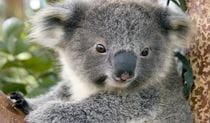Nightcap oak conservation project
The endangered nightcap oak is an ancient species with less than 150 mature trees remaining in the wild. NSW National Parks is working with the Saving our Species program and partners to ensure this rare species' survival.
Once widespread across Australia’s Gondwana rainforests, it survives today in a single, endangered population in the Nightcap Range, north of Lismore.
Under threat
As few as 150 mature trees remain in the wild, making this small, isolated population at very high risk of extinction.
Threats including wildfire and human disturbance have impacted habitat condition and species abundance, damaging exposed roots and fragile soils, and introducing invasive weeds and pathogens.
Under the Saving our Species (SoS) program, NSW National Parks and Wildlife Service (NPWS) are working with partners to manage risks and establish insurance populations.
A problem with dispersal
The nightcap oak belongs to a group of relict Gondwanan rainforest trees that have a common problem – they produce huge, nut-like seeds that no creature in their habitat today can swallow or move.
With the loss of animals like the pygmy cassowary, which is thought to have once dispersed the nightcap oak’s seeds, this species can’t expand its range. Even the largest rainforest seed couriers, like the wompoo fruit-dove and grey-headed flying-fox, are unable or uninterested in gobbling up and dispersing oak fruits.
Instead, seeds fall to the ground. While native rodent species are known to move the fruits short distances, they generally eat the seeds. So the trees are contained to their small site.
4 facts about the nightcap oak
Propagation and translocation
It’s now up to scientists to take up the job of establishing new populations of nightcap oak, to increase the wild population and ensure its long-term survival.
SoS and NPWS are working with rainforest scientists to collect seeds to propagate nursery stock. Notoriously difficult and slow to propagate, the rainforest specialist nursery has successfully raised more than 50 seed-grown plants, with another 20 seeds expected to germinate in spring 2021.
SoS has also partnered with the Australian Botanic Gardens, Mount Annan to grow plants from cuttings. These will supplement seed-grown plants, and provide genetic diversity for the new ‘insurance’ populations planted at translocation sites in the species predicted habitat under climate change predictions.
Extra protections
Several areas within NSW national parks have been declared Assets of Intergenerational Significance (AIS), providing the strongest legal protections for the nightcap oak and its habitat, to ensure its survival for future generations.
You might also like
-

Protecting threatened species in parks
Around 84% of the approximately 900 threatened species in NSW are found in our national parks and reserves. Find out what we're doing to protect threa...
-

Assets of Intergenerational Significance (AIS)
Assets of Intergenerational Significance (AIS) are declared to bolster protections for an area with exceptional environmental or cultural values, like...
-

Saving our Species conservation program
Today, we're at risk of losing nearly 1000 of our state's native animals and plants. That's why the NSW Government established Saving our Species. It'...
-

Threatened Species Framework for zero extinctions
The NSW National Parks and Wildlife Service (NPWS) Threatened Species Framework outlines actions to meet our commitment of zero extinctions and restor...







